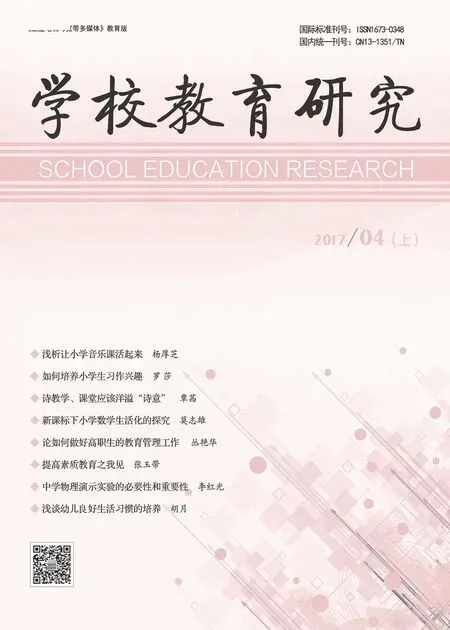Unit 5 What are the Shirts Made of?Section B(2a-2e)
——Beauty in Common Things教學(xué)設(shè)計
河南省洛陽宜陽縣第一高級中學(xué) 王慧娜
Analysis of the teaching materials
This is the second period of Section B from page 38 to 39. In this lesson, students will be guided to successfully express the Chinese traditional art by using the passive voice and master some reading skills.Section B will mainly consolidate the passive voice, which they have learned in previous lessons.Meanwhile, discussion in groups volunteering pair- works should be designed in the Prereading and Post-reading part to consolidate students’ mastery of vocabulary and improve their communication skills.
Three-dimensional targets
Knowledge and skills
1.To help students grasp new words and expressions relevant to Chinese traditional arts by giving pictures of the following words and phrases: clay,celebration, balloon, scissors,lively, historical, heat, polish,complete,paper cutting,be covered with, send out, sky lanterns.
2.To help students improve their reading ability by skimming, scanning and intensive reading.
3.To help students improve their oral English.
Process and methods
1.Sing a piece of Chinese traditional local opera to arouse students’ interest.
2.During Pre-reading ,a brainstorming related to Chinese traditional art forms and pictures presentation help students better memorize the new words and phrases.
3.In While-reading, the task-based language teaching method and the whole language approach are fully made use to help students form an overall comprehension of the text.
4.For Post-reading, students can form an independent attitude towards Chinese traditional art forms they are interested in by having a discussion.
Emotion, attitude and value
1.To arouse students’interest in Chinese traditional art forms.
2.To encourage students to inherit Chinese traditional culture and protect our culture heritage.
3. To enable students to enjoy the process of reading.
Teaching and Learning methods
1.The whole language approach
Use questions and pictures to help students better understand the “beauty” of Chinese traditional arts. Then, ask students to look through the whole text, encourage students to take part in the discussion and pair- work.
2.Task-based language teaching
The text deals with the theme of beauty in Chinese traditional arts. Pictures related to the theme will be presented by multimedia computers to broaden students’ horizons. Various kinds of tasks are arranged to examine students’ ability.
3.Evaluating and selfassessing learning
Through the task-based teaching, students need to make a self-assessment of their learning.
Teaching important and difficult points
1.To introduce the features of an object by using the new words and the passive voice.
2.To help students understand the function and significance of the passive voice and improve students’ comprehensive abilities.
3. To get to know more about Chinese traditional arts.
4. To cultivate students’duty in inheriting and protecting our Chinese traditional arts.
Teaching procedures
Step 1 lead-in
1. Warming-up by singing a piece of Chinese local opera.
T: My dear students, do you know what did I sing just now? An opera?
Ss: Opera....
T: Yes, it’s a piece of traditional Chinese local opera.Chinese opera is a kind of traditional art in China, what other Chinese traditional arts do you know?
Brain storming
Ss: Kite-making, yes! Paper cutting, Chinese knots…
T: Ok , brilliant! Today,we’re going to learn the passage of 2d-Beauty in Common Things.
Step 2 Pre-reading
1. Enjoy the pictures of Chinese traditional arts and learn the new words.
2. Provide every group with a piece of paper cutting as gift.
Step 3 while-reading
1. Scanning: Scan and answer the questions.
(1)What is the passage about?
(2)Which forms are talked about?
Know the new strategy in reading ---moving form general to specific.
2.Fast Reading
3. Intensive Reading
(1)Read para.1&2 and answer the questions.
(2)Listen and find the correct answers in para.3.
(3)Read para.4, guess and number the pictures, then tell how to make a clay piece with the clay.Proper answers: C A E B D.
4. Group work
(1)Every group pick up a task to do.
TASK 1
Translate the sentences into Chinese.
TASK 2
Complete the sentences using the correct forms of the phrases in the box.(2d)
Proper answers:
1. Send out; 2. rise, into,put, on; 3. such as, covered with.
TASK 3
Write down some important group words.
TASK 4
Discuss the questions in your group and give a report:
(1)Which art form do you think is the most interesting?Why? (2)Which art form would you like to learn? Why?
Step 4 Post Reading(pair work) Discuss with a partner and make a conversation:
What are special things that your hometown is famous for?
e.g.
Student A: What do you know about the art form Tang san cai?
Student B: San cai is a type of ceramics using three colors for decoration.
They are made of…
Step 5 Prolongation
Enjoy the pictures of Chinese traditional art forms( Tricoloured glazed pottery of Tang dynasty, Water table, Sugar figures, Palace lantern ) , and tell students that we own so many traditional art forms in china,but some of them are disappearing, as a Chinese teenager, we should try our best to inherit them and spread them to the world.

